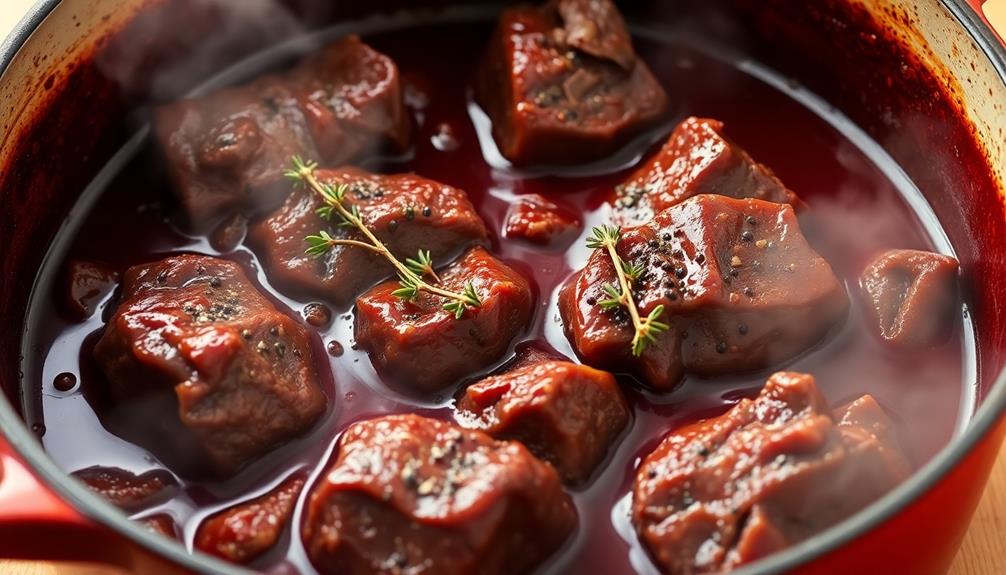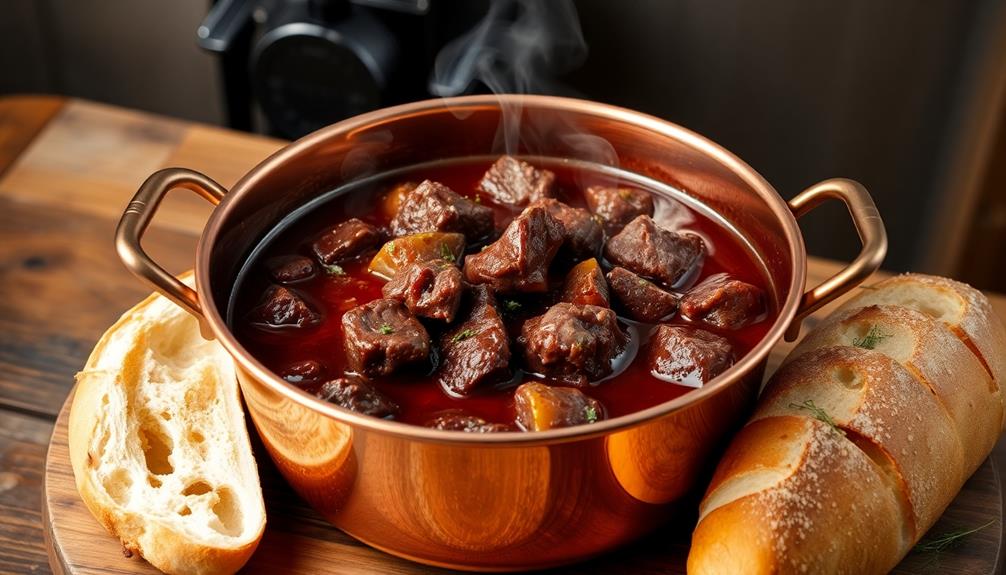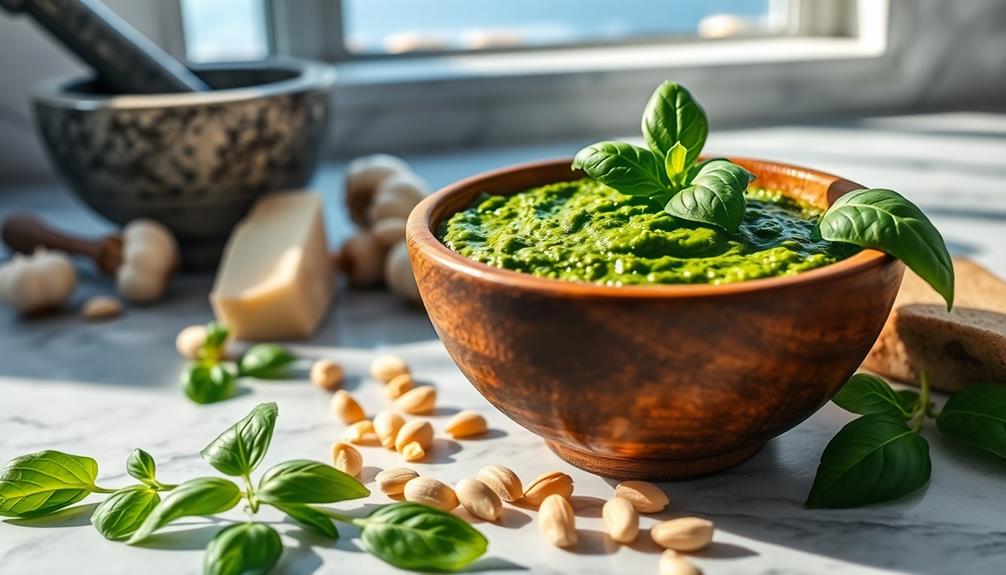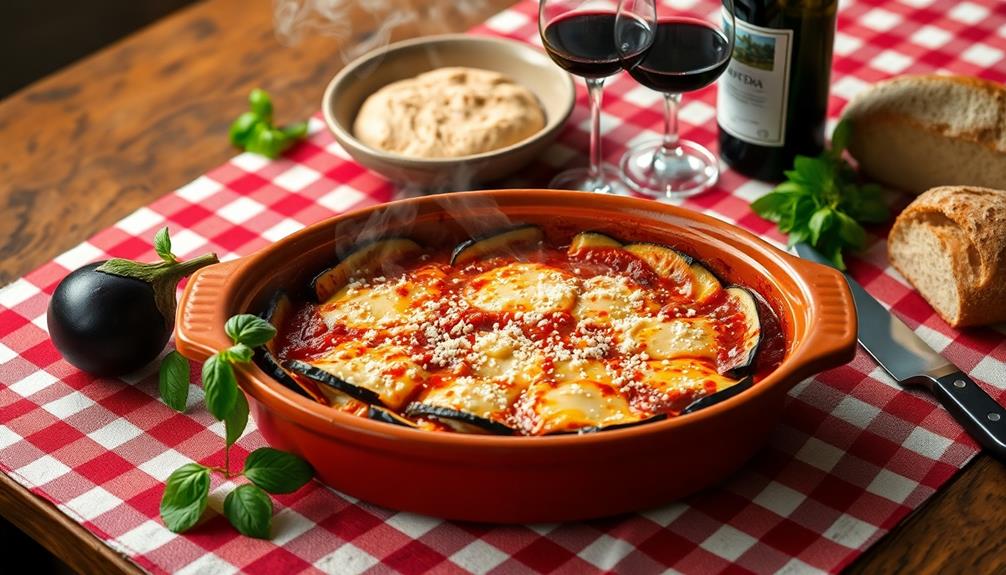Braised beef in Barolo wine is a cherished Italian dish that'll transport you to the cozy kitchens of Piedmont, where generations have savored its rich, velvety flavors and tender, melt-in-your-mouth texture. The secret lies in slowly simmering beef in the robust Barolo wine, along with aromatic veggies, until the meat practically falls apart. Serve this comforting dish over creamy polenta or buttered egg noodles, and don't forget to soak up the wine-infused sauce with crusty bread – it's a meal fit for family gatherings and special occasions. You'll soon discover why this dish is a beloved part of Italian culinary heritage.
Key Takeaways
- Braised Beef in Barolo Wine is a cherished dish originating from the Piedmont region of Italy, celebrated for its rich, complex flavors.
- The dish is traditionally enjoyed during family gatherings and special occasions, representing Italian culinary heritage and enhancing communal dining experiences.
- The recipe calls for slow-braising beef chuck roast in Barolo wine, along with aromatics and vegetables, to develop deep, velvety flavors.
- The braising technique ensures tenderness and allows the flavors to fully integrate, making it suitable for both novice and experienced cooks.
- The dish is often served over creamy polenta or with crusty bread, and is typically accompanied by a glass of Barolo wine for an enhanced dining experience.
History
The origins of braised beef in Barolo wine can be traced back to the Piedmont region of northwestern Italy. This hearty dish has been a beloved part of the local cuisine for generations, passed down from mothers to daughters, and shared at family gatherings and festive celebrations.
The rich, complex flavors of Barolo, a renowned red wine from the Langhe hills, perfectly complement the tender, succulent beef, creating a mouthwatering combination that's sure to delight your taste buds. As the beef simmers in the wine, it absorbs the deep, velvety notes, resulting in a dish that's both comforting and sophisticated.
Whether you're enjoying it on a cozy winter evening or celebrating a special occasion, this classic Piedmontese recipe is sure to warm your heart and fill your belly with joy.
Recipe
Braised Beef in Barolo Wine is a rich and flavorful Italian dish that combines tender beef with the bold, fruity notes of Barolo wine. This dish is perfect for a cozy dinner or a special occasion, as the long, slow cooking process results in fork-tender meat that practically melts in your mouth.
The key to this dish is letting the beef braise in the Barolo wine and aromatics for several hours, allowing the flavors to meld and the meat to become incredibly tender. The wine not only adds depth and complexity to the dish, but it also helps to tenderize the beef over the course of the cooking time.
- 3 lbs beef chuck roast, cut into 2-inch cubes
- 1 bottle Barolo wine
- 2 onions, diced
- 4 carrots, peeled and sliced
- 4 celery stalks, sliced
- 6 garlic cloves, minced
- 2 bay leaves
- 4 sprigs fresh thyme
- 2 tbsp tomato paste
- Salt and pepper to taste
In a large Dutch oven or heavy-bottomed pot, brown the beef cubes over medium-high heat in a bit of oil. Remove the beef from the pot and set aside.
Add the onions, carrots, celery, and garlic to the pot and sauté until softened, about 5-7 minutes. Pour in the Barolo wine and use a wooden spoon to scrape up any browned bits from the bottom of the pot.
Add the beef back to the pot, along with the bay leaves, thyme, and tomato paste. Season with salt and pepper. Bring the mixture to a simmer, then reduce the heat to low, cover, and let the beef braise for 3-4 hours, or until the meat is very tender.
When serving, be sure to spoon plenty of the rich, wine-infused sauce over the tender beef. This dish pairs beautifully with creamy polenta, buttered egg noodles, or crusty bread to soak up all the delicious flavors. Enjoy! For a complete Italian-inspired meal, consider serving this dish with a side of roasted vegetables or a fresh green salad. If you’re feeling adventurous, try making your own homemade spaghetti recipe to go with the flavorful beef and sauce. The combination of tender beef, savory sauce, and handmade pasta is sure to impress your family and friends at your next dinner gathering. Buon appetito!
Cooking Steps
First, you'll brown the meat to get a nice sear and lock in the flavors.
Then, you'll add the Barolo wine and let it braise on the stovetop, filling your kitchen with its rich, aromatic scent.
Step 1. Brown the Meat

To begin, grab a large, sturdy pan and heat it over medium-high heat.
Once the pan is nice and hot, it's time to add the beef. Carefully place the meat into the pan and let it sizzle! Don't be afraid to really brown the outside – that's where all the delicious flavor comes from. Use tongs to turn the meat every few minutes, making sure each side gets a nice, even color.
As the beef cooks, you'll notice it starts to release those amazing aromas. Breathe it all in and get excited, because you're on your way to creating a mouthwatering masterpiece!
Keep a close eye on the pan, adjusting the heat as needed to prevent any burning. Once the meat is beautifully browned all over, it's time to move on to the next step.
Get ready to deglaze that pan with some of that rich, velvety Barolo wine. Your kitchen is about to be filled with the most incredible scents!
Step 2. Add Wine and Braise

Once the meat is nicely browned, it's time to add the Barolo wine. This bold, full-bodied red wine from Italy's Piedmont region will infuse the dish with deep, rich flavors. Carefully pour the wine into the pan, scraping up any browned bits from the bottom. The wine will sizzle and steam as it hits the hot pan, releasing its aroma.
Let the wine come to a gentle simmer, then reduce the heat to low.
Now, cover the pan and let the meat braise for 2-3 hours, or until it's tender and falling apart. Basting the meat occasionally with the flavorful cooking liquid will ensure it stays moist and juicy.
As it simmers, the wine will concentrate, creating a sauce that coats the beef in a luxurious, velvety texture.
The patience pays off, as the long, slow braising process transforms the tough cut of meat into a meltingly tender delight. Get ready for your kitchen to be filled with the enticing aromas of this classic Barolo beef dish!
Step 3. Simmer Meat in Broth

With the meat browned and the wine added, it's time to let the dish simmer. Grab your trusty pot and pour in the rich, red Barolo wine. Mmm, can you already smell the deep, inviting aroma?
Next, add the broth – beef or chicken, whichever you prefer. Slowly bring the liquid to a gentle simmer, being careful not to let it boil too rapidly.
Now, nestle the seared beef back into the pot, making sure it's fully submerged in the flavorful broth. Put the lid on, leaving it slightly ajar, and let the meat braise away. As it simmers, the meat will become increasingly tender, soaking up all those wonderful wine and broth flavors.
Every 15-20 minutes, give the pot a gentle stir, basting the beef with the aromatic liquid. This helps ensure even cooking and prevents sticking.
Before you know it, your kitchen will be filled with the mouthwatering scent of this classic Brasato Al Barolo dish. Get ready for an utterly delicious meal!
Step 4. Incorporate Vegetables Into the Braise

As the beef simmers in the fragrant Barolo broth, it's time to add some vegetal goodness. First, dice up some carrots, onions, and celery. These classic Italian veggies will add lovely flavors and textures to the dish. Toss them right into the braising liquid, making sure they're submerged.
Now, let's get a bit fancy – add some mushrooms! Slice them up and drop them in. The earthiness of the mushrooms will complement the bold red wine beautifully. Don't forget to add a few sprigs of fresh thyme too – its fragrance will infuse the entire dish.
As the braise continues, the vegetables will become meltingly tender, absorbing all those incredible Barolo flavors. The mixture of meat, wine, and veggies will create a hearty, soul-warming meal.
Get ready for the house to be filled with the most tantalizing aromas! Your family is going to love this dish.
Step 5. Finish Cooking in Oven

To finish cooking the braised beef, transfer the pot to the oven. Set the temperature to 325°F (160°C) and let it cook for about 2 to 2 1/2 hours. This extra time in the oven will make the meat incredibly tender and infuse it with the rich flavors of the Barolo wine.
As the beef slowly simmers, the aroma will fill your kitchen, making everyone's mouth water. Keep an eye on the pot, adding a bit more broth or wine if the liquid level gets too low.
You'll know it's done when the meat is fork-tender and practically falling apart.
Once the braising is complete, carefully remove the pot from the oven. Let the beef rest for 10-15 minutes before serving. This allows the juices to redistribute throughout the meat, ensuring every bite is bursting with flavor.
Serve the Braised Beef in Barolo Wine over creamy polenta or buttered egg noodles, and enjoy this hearty, comforting dish with your loved ones.
Final Thoughts
Ultimately, you'll find this braised beef in Barolo wine a true delight. The tender beef, infused with the rich and complex Barolo wine, creates a symphony of flavors that will have your taste buds dancing. The slow-cooking process tenderizes the meat to perfection, making each bite melt-in-your-mouth delicious.
As you serve this dish, the aroma will fill the room, tantalizing your senses and setting the stage for a memorable meal. Whether you're gathering family for a cozy Sunday supper or hosting a dinner party, this dish is sure to impress.
The deep, velvety sauce pairs beautifully with creamy polenta or buttery mashed potatoes, creating a comforting and satisfying experience. Savor each morsel, allowing the flavors to linger and the warmth of the dish to envelop you.
This braised beef in Barolo wine is a true culinary delight, a dish that will become a cherished part of your family's traditions.
Frequently Asked Questions
What Makes Brasato Al Barolo Different From Other Beef Stews?
What sets brasato al barolo apart from other beef stews is the use of Barolo wine, a full-bodied Italian red, which adds a rich, complex flavor that elevates the dish beyond typical beef stews.
Can Brasato Al Barolo Be Made in a Slow Cooker or Instant Pot?
You can absolutely make a beef stew in a slow cooker or Instant Pot. The long, slow cooking process tenderizes the meat and allows the flavors to meld beautifully, just like traditional stovetop methods.
How Long Does Brasato Al Barolo Typically Take to Prepare and Cook?
Typically, a braised beef dish like this takes several hours to prepare and cook. You'll need to brown the meat, then simmer it slowly in the cooking liquid for 2-3 hours until it's fork-tender.
Can Brasato Al Barolo Be Frozen and Reheated for Later Use?
You can definitely freeze and reheat brasato al barolo for later use. The long cooking time makes it well-suited for batch cooking and reheating, so you can enjoy the rich, flavorful dish even on busy weeknights.
What Are Some Common Serving Suggestions or Accompaniments for Brasato Al Barolo?
When serving this dish, you can pair it with creamy polenta, buttered egg noodles, or roasted potatoes. It also goes well with a simple salad or some sautéed greens to balance the rich, beefy flavor.









